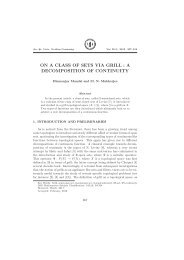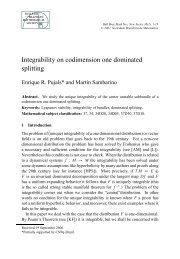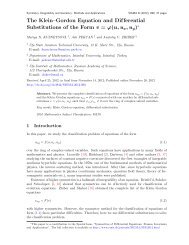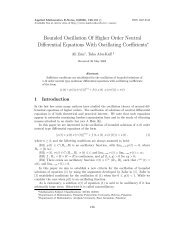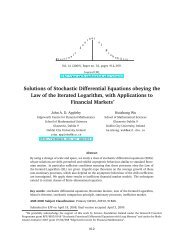ENRICHED INDEXED CATEGORIES Contents 1. Introduction
ENRICHED INDEXED CATEGORIES Contents 1. Introduction
ENRICHED INDEXED CATEGORIES Contents 1. Introduction
Create successful ePaper yourself
Turn your PDF publications into a flip-book with our unique Google optimized e-Paper software.
<strong>ENRICHED</strong> <strong>INDEXED</strong> <strong>CATEGORIES</strong> 637(ii) Morphisms in ∫ V :actA ⊗ ɛA HH❴❴ɛA × ɛA × ɛB 1×π×1ɛA × ɛBandactH ⊗ ɛB BH❴❴ɛA × ɛB × ɛB 1×π×1ɛA × ɛB(iii) The following diagrams commute.A ⊗ ɛA A ⊗ ɛA H 1⊗act A ⊗ ɛA HH ⊗ ɛB B ⊗ ɛB B act⊗1 H ⊗ ɛB Bcomp⊗1A ⊗ ɛA Hact Hact1⊗compH ⊗ ɛB Bact HactH ids A ⊗ ɛA HH ids H ⊗ ɛB BA ⊗ ɛA H ⊗ ɛB B act⊗1 H ⊗ ɛB B=actH=actH1⊗actA ⊗ ɛA Hact H.actWe have an obvious notion of morphism of profunctors, yielding a category which wedenote V -Prof (A, B).3.20. Examples. A Fam(V)-profunctor is equivalent to a V-functor B op ⊗ A → V,which is the classical notion of enriched profunctor; see for example [Bor94b]. Similarly,Self (S)-profunctors give the usual notion of internal profunctor; see e.g. [Joh02, §B2.7].3.2<strong>1.</strong> Example. For any small V -category A, there is a unit V -profunctor A: A −→ −↦ Adefined by the hom-object A. The action maps are simply composition in A.3.22. Remark. If A or B is a discrete V -category as in Definition 3.8, then the correspondingaction map is necessarily the unitality isomorphism. In particular, a profunctorδX −→ −↦ δY is simply an object of V X×Y , while a profunctor δX −→ −↦ B or A −→ −↦ δY is simplyan object of V X×ɛB or V ɛA×Y with a one-sided action of B or A, as appropriate. Thus,as in Remarks 3.11 and 3.16, we allow ourselves to abuse language by referring to suchdata as “V -profunctors” even if V lacks indexed coproducts.3.23. Example. If H : A −↦−→ B is a V -profunctor and f : A ′ → A and g : B ′ → B areV -functors, then there is a V -profunctor H(g, f) : A ′ −→ −↦ B ′ defined byH(g, f) = (ɛg × ɛf) ∗ H.The action maps are defined by composing the action maps of H with f.In particular, from any V -functor f : A → B and the unit profunctor B : B −→ −↦ B, weobtain representable profunctors B(1, f) : A −→ −↦ B and B(f, 1) : B −→ −↦ A.



